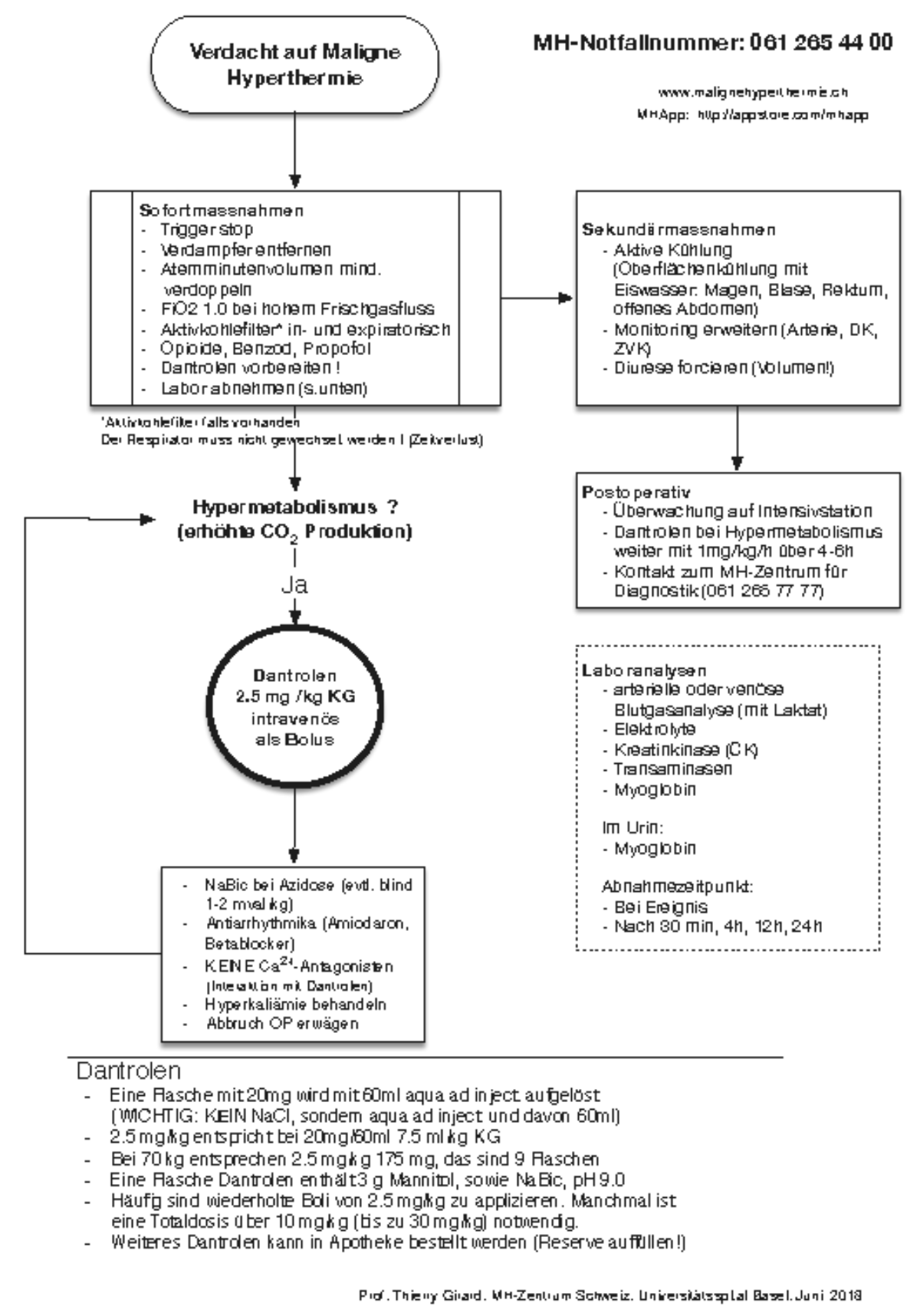Malignant hyperthermia
MH Diagnostics Center
Laboratory 408
Department of Biomedicine
Hebelstrasse 20
4031 Basel
Phone +41 61 265 77 77
info@malignehyperthermie.ch
There are usually two indications for referral for MH testing:
- MH susceptibility is known or suspected in the family
- The patient has experienced a suspected MH event themselves.
If the assigned person comes from a (suspected) MH family, we will examine the possibility of molecular genetic diagnostics. To make this easier for us, a family tree should be enclosed. This can be downloaded here. The family tree information is also important for people with a suspected MH episode because the MH predisposition is inherited in an autosomal dominant manner. Please send the available documents to the MH Diagnostic Center. We will then contact the patient directly and inform them about the possible examination (molecular genetics or in-vitro contracture test).
- If a genetic test is possible, we recommend that a blood sample be taken by the family doctor.
- If a muscle biopsy is indicated, we will contact the patient directly.
Important information
Emergency
In the event of a current MH emergency, dial the following number:
+41 61 265 44 00 (emergency number)
You will be put through to an anaesthetist at the University Hospital Basel. Please note: this is an emergency number. For information and administrative questions, please use the contact form.
Symptoms of an MH crisis
There are many different forms of MH crises. Basically, a distinction is made between a very rapidly occurring, so-called "fulminant" form and less rapidly (and less dramatically) developing forms.
There are several signs that indicate MH. Only rarely can MH be diagnosed with certainty based on the signs of the disease during anesthesia. It is much more common for MH to be suspected. This is no less important, because whenever MH is suspected, immediate and correct action must be taken in order to successfully treat an MH crisis
- Increased muscle tension (rigidity)
- Increased carbon dioxide (CO2) production
- Increased oxygen consumption
- Increase in pulse rate
The late signs of MH are
- Rise in temperature (can also be an early sign!)
- Dark coloration of the urine (myoglobinuria)
If you have had a suspected MH incident, you should be examined at an MH center to confirm or rule out MH susceptibility.
Anesthesia for MH sensitivity
Safe anesthesia procedures are available for people sensitive to MH. These include all regional anesthesia procedures. General anaesthesia can also be performed trigger-free. In both cases, it is essential to prepare the anaesthesia workstation accordingly. The dantrolene reserve must also be checked.
Monitoring of MH-sensitive patients should always include an ECG, non-invasive blood pressure measurement and oxygen saturation. In the case of general anesthesia, end-expiratory CO2 and temperature should also be measured continuously.
Extended monitoring (invasive blood pressure measurement, central venous catheter) should be established depending on the general condition of the patient and the extent of the surgical procedure. If the intraoperative course is problem-free, postoperative monitoring in an intensive care unit is not necessary due to MH sensitivity. Monitoring in the recovery room is always indicated. If MH-sensitive patients are anaesthetized, intensive medical care should be available.
Prophylactic treatment with (oral) dantrolene is obsolete today and is no longer carried out.
Workplace preparation
For MH-sensitive persons, trigger-free anesthesia must be performed. This also includes preparation of the workplace.
- Removal of the vaporizer
- Replacing the respiratory limescale
- Use of new breathing tubes
- Flushing the ventilator with 10 l/min fresh gas for at least 10 minutes. Recent literature has shown that this may not be sufficient with modern ventilators. Manufacturer-specific information on this should be requested. The use of an activated carbon filter can significantly reduce the preparation time.
- Caution: also applies to respirators in pre- and post-treatment
- NO prophylactic administration of dantrolene
- Check the dantrolene reserves
Postoperative intensive care monitoring should be available, but is only necessary if symptoms are suspicious for MH. With the exception of depolarizing relaxants and volatile anaesthetics, all medications are permitted.
Dantrolene reserves
At workplaces where MH trigger substances (volatile anesthetics, succinylcholine) are used, dantrolene should be immediately available. As a minimum, a first (preferably also a second) dose of 2.5 mg/kg must be available.
This amount is based on the patient population being treated and is considerably higher in an obesity clinic than in a pediatric anesthesiology department.
Internationally, a dantrolene reserve of 36 bottles is recommended.
It must be known where additional dantrolene can be organized quickly and at any time of the day or night if necessary.
Trigger substances and safe substances
Trigger substances prohibited in MH:
All inhaled anesthetics, i.e:
- Aether
- halothane
- enflurane
- isoflurane
- Sevoflurane
- desflurane
Depolarizing muscle relaxants are also trigger substances:
- Succinylcholine
- suxamethonium
Safe substances, permitted for MH:
The following substances are safe for MH-sensitive individuals regarding MH (this list is not exhaustive).
- Opioids
- ketamine
- etomidates
- barbiturates
- Benzodiazepines
- propofol
- Amide and esther local anesthetics
- Non-steroidal anti-inflammatory drugs (NSARD)
- Paracetamol
Muscle diseases associated with MH
Patients with myopathies that are also associated with mutations in the ryanodine receptor are at risk for malignant hypethermia and must be considered MH-susceptible. These myopathies are
- Central core disease (CCD)
- Multi minicore disease (MmD)
- King Denborough syndrome
- Nemaline myopathy
Forms of MmD and nemaline myopathy are also known which are associated with mutations in other genes. In general, it should be noted that only the above-mentioned muscle diseases are associated with a risk of MH.
Other muscle diseases can lead to hypermetabolic symptoms, which may look similar to MH symptoms. However, this is not a primary disorder of calcium homeostasis and therefore not malignant hyperthermia. With the exception of the above-mentioned myopathies, a general ban on inhaled anesthetics cannot be assumed. In these situations, it is important to weigh up the individual advantages and disadvantages of each anaesthetic for the patient in question.
This obviously does not apply to succinylcholine. Succinylcholine should not be used in patients with muscle diseases. Life-threatening situations are a possible exception, although alternatives are usually available here too.
Doctors and specialists



